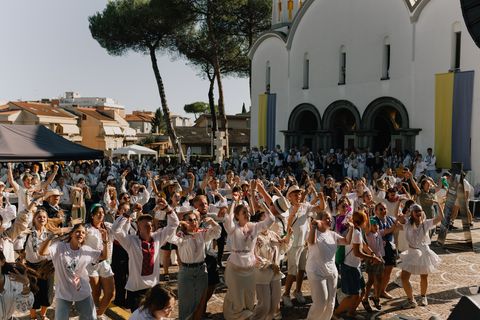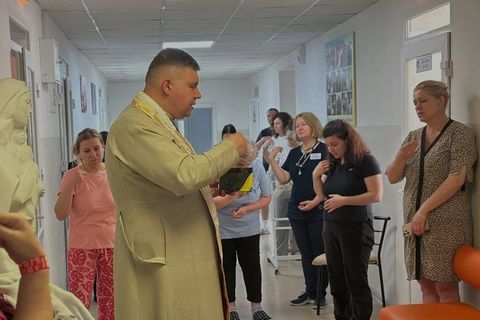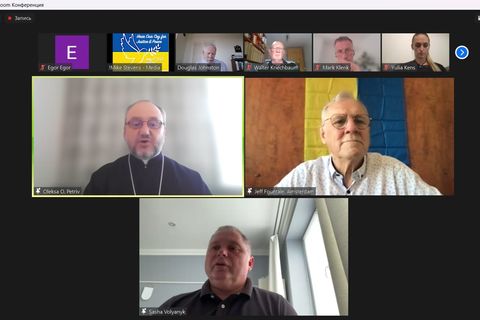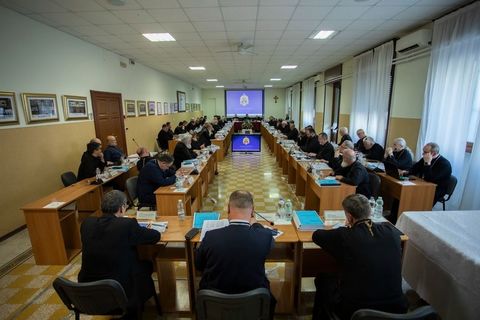
The Lviv Pseudo-Council of 1946: The History of the Russian World’s Special Operation
In two years, it will be the 80th anniversary of the Lviv Pseudo-Council, a large-scale special operation conducted by the NKVD and the Russian Orthodox Church to “finalize the issue” of the Ukrainian Greek Catholic Church. This was not the first attempt by imperial Russia—first tsarist, then Soviet—to destroy the UGCC. Today’s Putin’s Russia with its doctrine of “holy war” aims to destroy Ukraine itself.
Regarding the Greek Catholic (or Uniate) Church, Russian attempts to surpress it date back to the times of Peter the Great and Catherine the Great. During the nineteenth century, these attempts were fully realized in the lands captured after the third partition of the Polish-Lithuanian Commonwealth. This surpression is evident in the story of the Pratulyn martyrs, the story described in the diary of Fr. Hryhoriy Mitsevych, as well as in the destruction of Greek Catholic monasteries and their conversion to Russian Orthodoxy.
The “Russian world” is inherently unchanging: subjugation, destruction, dissolution, and complete disappearance are its goals and methods. The Ukrainian Greek Catholic Church has always been the target of such destruction, primarily because it had a distinct national face. It nurtured Ukrainians as a nation, gave the people a sense of dignity and strength to resist, and affirmed the idea that Ukraine has always existed, and will continue to exist.
After the events of 1946, the UGCC went underground. Despite repression, persecution, and the threat of exile and death, people did not abandon their faith, themselves, or dissolve into the “acid” of the Soviet empire. The Church lived, served, stood, was with its people, left the world numerous examples of righteousness. It left numerous examples of righteousness and left a treasure of great and true faith to its descendants.
Fr. Taras Bublyk, a senior lecturer at the Institute of Church History of UCU, discusses the Lviv Pseudo-Council of 1946, its background, causes, and behind-the-scenes events in “Stories from the History of the UGCC.”
Soviet occupation: “Aim for the complete elimination of the Uniates”
In the spring of 1944, the Soviet army entered western Ukraine, driving out German troops. On July 27, 1944, Lviv was occupied, and soon the entirety of Galicia was once again under Soviet control, as it had been after 1939.
On November 1, 1944, Metropolitan Andrey Sheptytsky died in Lviv at the age of 79. His 40-year ministry marked an era for the Greek Catholic Church and Ukrainians in Galicia. Josyf Slipyj, who had been appointed as Andrey Sheptytsky’s assistant and successor in December 1939, assumed the metropolitan’s throne.
The majestic and illustrious figure of Metropolitan Andrey restrained the Soviet regime from outright repression of the Church. In September 1944, with the sanction of Moscow, the NKVD sent a representative to negotiate with Metropolitan Andrey. Sheptytsky assured him that the Church would be loyal to the new government if it guaranteed Greek Catholics freedom of faith. Metropolitan Josyf Slipyj also hoped that the new course in Soviet religious policy, outlined since 1943, would also apply to Greek Catholics.
In December 1944, a delegation led by Archimandrite Klymentiy Sheptytsky traveled to Moscow to find a modus vivendi with the new government. Despite all the attempts of the UGCC leadership to reach an understanding with the state authorities of the USSR, in February 1945 the Soviet leadership decided to completely liquidate the Church.
The plan of the NKVD of the Ukrainian SSR, dated February 8, 1945, stated: “The Greek Catholic Uniate Church, as it exists, is a legal residence of the Vatican, alien to our influence, and an active Ukrainian nationalist organization. In view of this, we must pursue the complete liquidation of the Uniates on our territory and the separation of the Greek Catholic Church from the Vatican in order to reunite it with the Orthodox Church in the Soviet Union.”
The commencement of the “operation”
The signal to start the campaign was the article “With a Cross or a Knife?” published in all republican and regional newspapers of the Ukrainian SSR on April 8–10, 1945. Its author, who wrote under the pseudonym “Volodymyr Rosovych,” was a Galician communist writer named Yaroslav Halan, who had been a secret employee of the Soviet secret services since 1939. However, the main content of the article was dictated to Halan by NKVD Colonel Serhii Karin-Danylenko, one of the authors of the plan to liquidate the Greek Catholic Church.
Shortly after the plan was approved, on March 15, 1945, an order was issued to prepare for the arrests of Greek Catholic bishops. The arrests themselves took place on the night of April 12. As a result, on April 25, 1945, as many as 50 Greek Catholic priests were arrested in Lviv and the regions, in addition to the metropolitan and four bishops. At the same time, the Theological Academy and Seminary in Lviv were closed, and their 259 students were conscripted into the Soviet army.
The Greek Catholic clergy repeatedly appealed to the authorities protesting against the arrests of clergy and the campaign of forced conversion to Orthodoxy. One such protest, signed by Father Klymentiy Sheptytsky and 60 other priests, was sent in July 1945 to Deputy Chairman of the Council of People’s Commissars Molotov, and another to the head of the Council for Religious Cults, Poliansky.
The initiative group and Havryil Kostelnyk
Immediately after the arrests of the bishops, the NKGB set about creating an initiative group to “reunite” the UGCC with the ROC. Father Havryil Kostelnyk, a renowned theologian, agreed to become the spokesman for this group, despite his long history of conflicts with the Vatican and hostile relations with Metropolitan Josyf Slipyj.
Long aware of Father Kostelnyk’s anti-papal sentiments and adept at playing on his ambitions, Lieutenant Colonel Karin convinced him to lead the “reunification” campaign on April 14, 1945.
The creation of the initiative group was delayed until May 31, 1945, due to difficulties in finding representatives from the dioceses of Przemyśl and Stanisławów. In the end, the central initiative group consisted of Father Mykhailo Melnyk, vicar general of the southeastern deaneries of the Przemyśl diocese, and Father Antin Pelvetsky, dean of the Kopychynets deanery of the Stanisławów diocese.
Father Kostelnyk himself colluded with the NKGB voluntarily, while most of the “initiators” were agents of the security services. By the decision of the Council of People’s Commissars of the Ukrainian SSR, the initiative group was recognized as the governing body of the UGCC and arrogated to itself the powers of the arrested bishops, including the right to appoint and transfer priests and deans. Priests who did not recognize the jurisdiction of this group were faced numerous difficulties or even complete impossibility of pastoral work by local authorities.
”Soborchyky” Campaign
Long before this initiative group was established, in April 1945, the regional NKGB offices launched a massive campaign to identify supporters of Orthodoxy and recruit agents among the Uniates. Simultaneously, those who opposed “reunification” were arrested. Reports on the results were sent every five days to Lviv, where the headquarters of the special task force of the NKGB of the Ukrainian SSR was located.
Beginning in July 1945, Father Kostelnyk, together with KGB Captain Bohdanov, who posed as the Commissioner for Cults, held “soborchyky” (“little councils”) in the deaneries of the Lviv Archdiocese to garner support for the initiative group. Prior to these meetings, local NKGB functionaries processed priests, and agents recruited by them spoke at the “soborchyky” as supporters of Orthodoxy. Similar meetings were held by Fathers Pelvetsky and Melnyk.
The initiative group itself did not refrain from direct threats. Father Petro Shturma from the village of Stanislavchyk received the following letter: “In your area, all the priests have joined the initiative group, except for you. Do you not thus draw special attention to yourself and do you not create danger for yourself?”
Despite eventually “reuniting” with the ROC, Father Sturma was arrested in 1950.
Russian Orthodoxy in Lviv
At the Kremlin’s behest, the higher Orthodox clergy also joined the campaign to “reunite” the Uniates. The newly elected Moscow Patriarch Alexy Simansky called on Greek Catholics to convert to Orthodoxy.
In April 1945, Orthodox Bishop Makariy Oksiuk, an NKGB agent under the pseudonym “Hlibov,” was appointed to Lviv.
At the same time as searching for and recruiting supporters of “reunification,” the repressive authorities also identified opponents of the transition to Orthodoxy. Particular attention was paid to deans, through whom the NKGB hoped to influence the rest of the clergy. Most of those who did not support the initiative group were arrested, and the rest were dismissed from their positions.
Resistance
The greatest resistance to the “reunification” campaign came from the monasticism. In preparation for the council, monasteries in larger cities and towns were closed. Monks were dispersed to one or two monasteries in remote areas, and the most active among them were arrested.
Despite the intimidation and pressure, not all the “soborchyky” were held as planned.
For example, at a meeting of the Zolochiv deanery, the dean, Father Volodymyr Lysko, read a statement condemning the actions of the initiative group, which had been signed in advance by all the priests. Soon after, Father Lysko was arrested.
At the “soborchyky” of the Rava-Rus and Zhovkva deaneries, Father Ilya Blavatsky sharply criticized Father Kostelnyk. As a result, none of those present signed up to join the initiative group. Shortly thereafter, Father Blavatsky was also arrested.
Preparations for the Lviv Pseudo-Council
In persecuting the Ukrainian Greek Catholic Church, the Soviet authorities took historical examples and methods from the nineteenth century, when the Union was liquidated on the lands occupied by Tsarist Russia, as a model. Initially, the NKGB and Patriarch Alexy were against convening a general Galician church assembly or council, preferring the individual transfer of priests to the jurisdiction of the Russian Orthodox Church.
At the insistence of Father Kostelnyk and ROC Bishop Makariy, it was decided to convene a “single council” in Lviv in March 1946, finalized in mid-December 1945.
On January 25, 1946, this plan was authorized by Moscow. To implement it, a special task force of the NKGB of the Ukrainian SSR, headed by Deputy People’s Commissar Lieutenant General Drozdetsky, was sent to Lviv. Delegates to the council were selected by the initiative group, in collaboration with the NKGB, from among trusted agents or priests loyal to the Soviet government.
According to the plan of the NKGB of the Ukrainian SSR, in order to give the “council” the appearance of canonical legitimacy, it was decided to ordain two of its participants, members of the central initiative group, Father Melnyk and Father Pelvetsky, as bishops beforehand.
To this end, a delegation of Greek Catholic priests was sent to Kyiv on December 18, 1945. The members of this delegation “reunited” with the ROC on February 22 and participated in the ordination ceremonies at the Kyiv Cave Monastery.
To demonstrate the fraternity between Greek Catholics and Orthodox Christians and to gauge the population’s reaction to the “reunification” action, Father Kostelnyk and Bishop Makariy, on behalf of the NKGB, held a joint blessing of water in Lviv’s Rynok Square on January 19, 1946. Similar joint water blessings were held in Drohobych and Stanislaviv with the participation of Fathers Melnyk and Pelvetsky, along with local Orthodox priests.
”Council” planned by the NKGB-ROC
Through its district departments, local Soviet bodies, and ROC structures, the NKGB organized the preparation of delegates, their arrival in Lviv, accommodation, food, and security. The NKGB also provided funding for all these activities. Delegates to the “council” were selected by the NKGB, in conjunction with the initiative group, subjecting each to a thorough agent check and briefing. Two representatives from each deanery were sent to Lviv, a dean and another priest. In total, 216 delegates from the clergy and 19 delegates from the laity took part in the “council.” It is noteworthy that about 70 % of the participants of the “council” were recruited by the Soviet special services.
On March 8, 1946, the delegates of the “council” unanimously decided to “reject the decisions of the Council of Brest in 1596, dissolve the Union, disaffiliate from the Vatican and return to our parental holy Orthodox faith, the Russian Orthodox Church.”
The next day, telegrams to Stalin, Khrushchev, the Chairman of the Supreme Soviet of the Ukrainian SSR, Hrechukha, and Patriarch Alexy were approved by the NKGB.
The council proceeded strictly according to the pre-established plan. The only unexpected event was the speech by Father Vasyl Lesiuk from the village of Razhnov, who proposed that the council should be considered merely a preliminary meeting, and that no final decisions should be made regarding the transition to Orthodoxy. However, no one else dared to support him. Shortly after the council, Father Lesiuk was arrested.
The Flywheel starts
On March 10, 1946, on the first Sunday of Lent, known as the Sunday of Orthodoxy, a solemn service was held at the Cathedral Church of St. George in Lviv. During this service, the decisions of the “council” were publicly proclaimed, and the participants immediately reunited with the ROC. Ordinary priests had to canonically formalize their conversion to Orthodoxy by applying to Orthodox bishops or their authorized deans. Only then could they receive registration from the authorized representative of the ROC Council for Foreign Affairs. Those who refused to “reunite” were forced to leave their parishes. Some were offered low-paid secular labor, while others faced imprisonment in camps or exile.
Some of the “reunited” priests soon withdrew their statements due to remorse. Father Mykhailo Lishchynsky, upon learning that his name had been included in the published list of “reunited” priests, appealed to Bishop Makariy with a statement that he was and remains a Catholic. After that, he was forced to leave the parish and worked as an accountant in Lviv. Father Vasyl Baran “reunited” in 1946, but in March 1948, in a letter to Bishop Makariy, he announced his disaffiliation with the ROC. For some time, he served without registration until he was arrested in 1950.
Later, the anniversaries of the Lviv “Council” became an occasion for solemn celebrations and the intensification of the struggle against “the remnants of Uniatism.”
The Lviv Pseudo-Council of 1946 marked the beginning of more than 40 years of the way of the cross for Ukrainian Greek Catholics. Repressions against the clergy and faithful, launched as part of the “reunification” special operation, continued, grinding hundreds and thousands of lives in their millstones.
Following Galicia, the Greek Catholic Church was officially banned in Transcarpathia and Poland. Following a scenario elaborated in Moscow, “councils” like the one in Lviv were organized in Romania and Czechoslovakia as well.
The Church withstood
However, the decision to liquidate the Union was not recognized by the Apostolic See, the imprisoned Greek Catholic bishops, part of the clergy, or the majority of the faithful. This was evident in the events of the late 1980s, during which it became clear that they had not forgotten to which Church they belonged.
In his message on the occasion of the 70th anniversary of the Lviv Pseudo-Council, His Beatitude Lubomyr Husar stated: “The great life-giving lesson of our past is that the Church, which grew due to its openness to others and a sincere desire for unity, managed to survive despite prohibitions and liquidations, giving the world true martyrs for the faith.
The Church, declared liquidated by the Lviv pseudo-council, survived the period of persecution, organized itself in the underground, nurtured the next generations of church leadership and faithful, returned to the lands where it had once functioned and been destroyed several centuries ago, spread to new territories outside Ukraine and awaited the Holy Feast of Resurrection in its native land.”
Prepared by Oksana Kozak,Information Department of the UGCC



